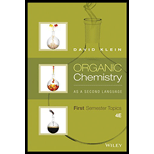
Concept explainers
Interpretation:
All the lone pairs of electrons that is present in the given structure has to be drawn.
Concept Introduction:
Lone pair of electrons are the pair of valence electrons that are not involved in bonding with other atoms. These are also called as non-bonding pair. Formal charge and lone pair of electrons are more important in representing a correct structure. If we know the formal charge on an atom, the lone pair of electrons can be found and vice-versa. The simple convention is to ignore the lone pairs and always show the formal charge. To find the lone pair of electrons present on an atom, few steps has to be followed and they are listed below,
- Valence electron of an atom has to be found according to the periodic table.
- Formal charge on the atom has to be considered. Positive charge means one electron less and a negative charge means one electron is more.
- The difference between the valence electron and the formal charge gives the lone pair of electrons that is present.
If the compound contains carbon atom and there is no formal charge present on the carbon atom means it will have four bonds and no lone pair of electron.
If the carbon atom has a formal positive charge means, then the carbon atom will have three bonds and no lone pair of electrons.
If the carbon atom has a formal negative charge means, then the carbon atom will have three bonds and one lone pair of electrons.
Want to see the full answer?
Check out a sample textbook solution
Chapter 1 Solutions
Organic Chemistry As a Second Language: First Semester Topics
- Draw the mechanism for the formation of diol by starting with one pen and all in... basic conditions then acidic conditions then draw the mechanism for the formation of a carboxylic acid from your product.arrow_forwardDraw the mechanism for the oxidation of 3-bromo-cyclohexan-1-ol.arrow_forwardConvert the following Fischer projection to Haworth projections. show work and show the arrows please.arrow_forward
- Draw the mechanism for the substitution reaction converting an alcohol into an alkyl halide. If chirality is important to the reaction include it.arrow_forwardWrite, in words three different reactions we can use to make an alcohol.arrow_forwardDraw the reduction mechanism for the reduction of the aldehyde.arrow_forward
 ChemistryChemistryISBN:9781305957404Author:Steven S. Zumdahl, Susan A. Zumdahl, Donald J. DeCostePublisher:Cengage Learning
ChemistryChemistryISBN:9781305957404Author:Steven S. Zumdahl, Susan A. Zumdahl, Donald J. DeCostePublisher:Cengage Learning ChemistryChemistryISBN:9781259911156Author:Raymond Chang Dr., Jason Overby ProfessorPublisher:McGraw-Hill Education
ChemistryChemistryISBN:9781259911156Author:Raymond Chang Dr., Jason Overby ProfessorPublisher:McGraw-Hill Education Principles of Instrumental AnalysisChemistryISBN:9781305577213Author:Douglas A. Skoog, F. James Holler, Stanley R. CrouchPublisher:Cengage Learning
Principles of Instrumental AnalysisChemistryISBN:9781305577213Author:Douglas A. Skoog, F. James Holler, Stanley R. CrouchPublisher:Cengage Learning Organic ChemistryChemistryISBN:9780078021558Author:Janice Gorzynski Smith Dr.Publisher:McGraw-Hill Education
Organic ChemistryChemistryISBN:9780078021558Author:Janice Gorzynski Smith Dr.Publisher:McGraw-Hill Education Chemistry: Principles and ReactionsChemistryISBN:9781305079373Author:William L. Masterton, Cecile N. HurleyPublisher:Cengage Learning
Chemistry: Principles and ReactionsChemistryISBN:9781305079373Author:William L. Masterton, Cecile N. HurleyPublisher:Cengage Learning Elementary Principles of Chemical Processes, Bind...ChemistryISBN:9781118431221Author:Richard M. Felder, Ronald W. Rousseau, Lisa G. BullardPublisher:WILEY
Elementary Principles of Chemical Processes, Bind...ChemistryISBN:9781118431221Author:Richard M. Felder, Ronald W. Rousseau, Lisa G. BullardPublisher:WILEY





